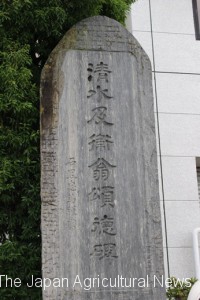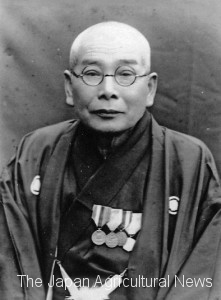Foresight for surpass the hardships
Before the legislation of sangyokumiai (cooperatives), there was the person who was said to be the pioneer of the sakgyokumiai in Gunma prefecture. He is Tomoe Shimizu. Tomoe lost his father 5 days later of his birth and was brought up to his mother. After graduated from high elementary school at the age of 16, he became a householder and married at the young age of 19. His daily routine work was to beat the straw in dirt floor and free rope. Tomoe had athletic body and worked rapidly. His caring reputation was also good.
Kise village (Maebashi City), Seta District of Gunma Prefecture, was involved in a conflagration that burn the majority of the village in 1889 (Meiji 22). Three years later the main houses were reconstructed, but many houses had no barn house.
In order to overcome the hardship, 26 of comrades decided to create cooperatives to knit rope every night and ship 30 bunches in one month. The official name of the cooperatives was “Nonaka Kyodokumiai (Nonaka cooperatives)”, but people had called it “Tsuminawakumiai (Rope loading cooperatives)”. Tomoe, who called for establishment by visiting each home nevertheless he was the youngest householder in all householders, became cooperatives president.
Tomoe was thoughtfully sunk talked to himself, “Even so …, what is the cause of poverty?” Tomoe skipped 1 year at elementary school, and graduated from higher elementary school in one year. He tried to track down the reasons. One day, he went to Maebashi in order to repay the moneylender. He asked the mechanism of high interest rate. Based on the answer, He understood mechanism of interest rates to have to include loss of default loan. He noticed the trick that “Honest people pull the short straw”.
◇

The monument of Tomoe Shimizu built on the grounds of the Chuokai (general association) of JA of Gunma prefecture (Maebashi city). Its calligraphy was described by Tadaatsu Ishiguro, said to be “god of agricultural policy.”
Nonaka kyodokumiai had philosophy composed with three fundamentals as follows;
1) to be honest, 2) to work with a sense of gratitude, 3) to save money every month so as to prepare the disaster.
Tomoe read not only agricultural books but also many books related to Sontoku Ninomiya at this time.
When it became time to buy fertilizer of spring, Tomoe proposed, “Let’s stop to buy fertilizer individually from this year. Cooperatives should buy in one hand.” At the case of selling collectively, fertilizer sellers study reasonable price. He added consultation. “In addition to the Gyohi (fish fertilizer) and soybean meal, I would like to try using a new artificial fertilizer, superphosphate. ” It was the things that Komaba Agricultural College had imported for the test from the United States. Tomoe went to Tokyo, and bought it in the name of Nonaka kyodokumiai.
Nonaka kyodokumiai reserved a portion of the profits through joint sales of the product and joint purchase of the necessities as cooperatives savings, and evolved in the form of a credit cooperatives lending money to people in need.
Hirata and Ministry of Agriculture and Commerce encouraged
In spring of 1898 (Meiji 31), He tried for the first time “ensuisen (the salt water election method of rice seeds)”. Ensuisen is the method to differentiate the quality of the seeds by using the specific gravity of the salt water. Tokiyoshi Yokoi, the first president of Tokyo University of Agriculture, invented it.
When his work was completed, deputy mayor of the town came rushed to him running the rickshaw. He said, “Tomoe san, it was supposed to be serious. Together come to office riding in this car.” In the office, Tosuke Hirata of the Ministry of Agriculture and Commerce was waiting. Hirata was the person to be president of sangyokumiai-chuokai (general association of cooperatives) later.
Hirata was surprised at what Tomoe was doing a “ensuisen (salt water election method)”. Although rono (elderly experienced farmer) and budding scholar of agricultural science had been proposed the method in 1887 (Meiji 20), but it had not been practiced yet. It was 5 years later (1903 (Meiji 36)) when The Ministry of Agriculture and Commerce ordered the dissemination of the method to nationwide nokai (chamber of agriculture).
“I’m even now studying sangyokumiai (cooperatives). But I was noticed that Nonaka kyodokumiai, the fine senior entity in Japan, was established in 1892 (Meiji 25). I and Shinagawa were surprised looking at each other. That’s why immediately I rushed to this place.”
Tomoe became red to hear it, and had head down.
“We do not know anything. We didn’t learn to anyone. We only want make the world more human, more honest, and something where honest people don’t pull the short straw …”
Furthermore, Hirata encouraged him while saying, “That’s the reason that we are so surprised. This is a senior and template of sangyokumiai (cooperatives) that we are thinking. Please grow to respectable cooperatives.” (Tsutou Wada, “Nihon no nojinden (biography of farmers of Japan) ” fifth Volume = Ienohikarikyokai (home light association)


